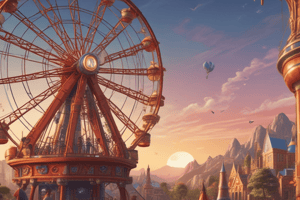Podcast
Questions and Answers
The first roller coasters were built in France.
The first roller coasters were built in France.
True (A)
Roller coasters rely on the force of ______ to keep them moving.
Roller coasters rely on the force of ______ to keep them moving.
gravity
What was the top speed of the Switchback Railway?
What was the top speed of the Switchback Railway?
- 10 kilometers per hour
- 190 kilometers per hour
- 120 miles per hour
- 6 miles per hour (correct)
What feature was added to early roller coasters to prevent cars from rolling backwards?
What feature was added to early roller coasters to prevent cars from rolling backwards?
Match the roller coaster features with their purpose:
Match the roller coaster features with their purpose:
Flashcards
Origin of Roller Coasters
Origin of Roller Coasters
Roller coasters originated from wooden and ice slides in Russia over 300 years ago.
Early Roller Coaster Safety
Early Roller Coaster Safety
Early roller coasters were dangerous with many accidents before safety features were added.
Switchback Railway
Switchback Railway
Built in 1884 at Coney Island, it was the first roller coaster resembling modern designs.
Potential Energy
Potential Energy
Signup and view all the flashcards
Gravity's Role
Gravity's Role
Signup and view all the flashcards
Modern Roller Coaster Features
Modern Roller Coaster Features
Signup and view all the flashcards
Top Thrill Dragster
Top Thrill Dragster
Signup and view all the flashcards
Design Challenges
Design Challenges
Signup and view all the flashcards
Study Notes
Roller Coaster History and Design
- Roller coasters originated in Russia, with early models featuring wooden and ice slides for winter festivals.
- These early coasters were tall, often reaching the height of an eight-story building.
- Initially, sleds were carved from ice blocks, lacking brakes, and relied on sand at the bottom for slowing down.
Evolution of Roller Coaster Design
- Later models in France incorporated wheeled cars locked to tracks, marking a significant advancement in safety.
- Early roller coasters were associated with many accidents.
- A prime example is the Switchback Railway at Coney Island, opened in 1884, featuring a small train ride down a 600-foot slope. This early coaster had a top speed of only six miles per hour.
Modern Roller Coaster Features and Developments
- Modern advancements include new wheels preventing track departures and safety chains to prevent backward movement.
- Track inclines (banking) on turns improve speed and smoothness.
- Today's roller coasters are diverse in style and speed, with examples like the Top Thrill Dragster in Ohio achieving speeds of 120 miles per hour.
Roller Coaster Design Principles
- Roller coaster design prioritizes safety alongside speed, twists, loops, and thrilling drops.
- The planning and modeling process involves careful computer simulations.
- Roller coaster construction is divided into parts, assembled, and comprehensively tested before public opening.
- The design is heavily reliant on understanding gravity's influence. Potential energy at the hill's summit transforms into kinetic energy as the cars accelerate.
- Forces like friction are vital considerations in the design process.
Roller Coaster Construction Time
- The design and development process for a new coaster takes approximately a year.
Studying That Suits You
Use AI to generate personalized quizzes and flashcards to suit your learning preferences.




